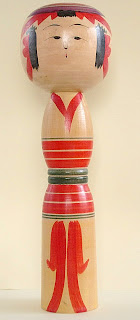"Free from Tradition" -Yajiro kokeshi
Background of Yajiro
"Yajiro"(弥治郎) is originally a person's name,which comes from a local legend that a surviving warrior with the name hid and lived there.
(incidentally,the ending of the word "ro"("郎" or "朗") is a popular given name for boys - for example,"Ichi-ro".)
It is a small village of Kijishi(craft workers) like Toggata.And the production of kokeshi started from the latter half 19th.Its target market was Kamasaki onsen(hot spa area),where is far about one mile from the village.
Yajiro is also located in the foot of Mt.Zao as Toggata is.As I discuss later,this geographical condition relates to Yajiro kokeshi's design significantly.
Children of Togatta Kokeshi
Yajiro kokeshi originally come from Togatta kokeshi -both villages are relatively close to each other in the same foot of Mt.Zao.In fact,early Yajiro's artisans positively introduced the skills and design of Togatta kokeshi into their works.
- artisan : Fukuo Niiyama
- type : Yajiro
- tall : 31cm(12inch)
- max width : 9.5cm(3.7inch)
- max circumferences : 30cm(11.8inch)
As you can see,this doll is large-headed,and this is the feature of the type Togatta kokeshi.It shows a piece of evidence that they both has been "parent and child".But the kids had much "independent-mind".
Switched-on Kokeshi
She has a "body like a bottle".I don't know whether the body line was inspired by Coke,but definitely this is one of Yajiro kokeshi's own characteristics.Yes,Yajiro's artisan had much enterprising spirits.I hear some old kokeshi wore their hair in topknots,and some wore muffler.
The second characteristic is "wear a beret".See below picture.

Why is this stripe patterns around her head called "beret"? I don't know exactly,but more popular was the beret with dark green or purple at the time in Japan.The point is a variety of shade.Now most artisans paint their works with many colours,but the pioneers were Yajiro's artisans.Moreover,some of them had moved from place to place to craft kokeshi - I think their such flexibility also shows they are of Kijishi's origin.So,now artisans of Yajiro group live and craft kokeshi in many areas.
Today,where is the pioneer spirit of Yajiro? Of-course,it still remains in modern Yajiro's artisans.Some are trying to pursue their own originality with respecting its traditional design.I think the essence of tradition in Yajiro is their such attitudes toward works.

